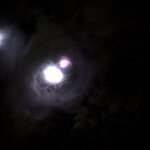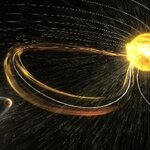Aerospace

Cardiovascular disease affects around 46 percent of men and 48 percent of women but scholars in Florida are concerned that Apollo astronauts have died from related diseases 43 percent of the time. Why be worried, when it is lower? Because they have exceptional government health care, not the kind people under the Affordable Care Act get, and that means in a spacefaring environment, there could be unforeseen issues.
It is well-documented that age is the biggest risk factor for all diseases, and cardiovascular disease is the big killer of Americans. The Apollo program began 50 years ago so it…

ESA astronaut Tim Peake took this image circling Earth 400 km up in the International Space Station. He commented: “Sometimes looking down on Earth at night can be kinda spooky.”
The image shows lightning strikes illuminating clouds over Western Australia during a thunderstorm. The Space Station travels at 28 800 km/h so it takes only 90 minutes to complete an orbit of Earth. Astronauts often spot thunderstorms and are impressed by how much lightning they observe.
Although this picture was taken in Tim’s free time, the Station is used for research into elusive phenomena in the upper…

http://theconversation.com/rise-and-shine-new-horizons-awakes-ahead-of-a...
While the Mars Rovers and the Rosetta spacecraft will continue to make headlines in 2015, the stage is set for the solar system’s next great mission – the Pluto-bound New Horizons.Discovered in 1930, it was assumed that Pluto was a planet, with a mass comparable to that of the Earth. This was partially based on its brightness, along with the mistaken assumption that it was perturbing the orbits of Neptune and Uranus.As the decades passed, and our observations of Pluto improved, its estimated mass dropped: smaller…

What happens to your body in space? NASA's Human Research Program has been trying to provide answers for a decade.
Nature is out to kill us all on earth and space is no different. On top of that, we are isolated from family and friends, exposed to more radiation that could increase lifetime risk for cancer, eat a diet high in freeze-dried food, and work hard all while confined with three co-workers picked by your boss.
Scott Kelly will be the first American to spend nearly one year in space aboard the International Space Station, twice the normal time. One year is a stepping stone to a…

Researchers have learned more about what happened to the climate on Mars since it was a warm and watery planet billions of years ago.
The researchers announced on Thursday that NASA's MAVEN (Mars Atmosphere and Volatile Evolution) mission has determined the rate at which the Martian atmosphere currently is losing gas to space via stripping by the solar wind. Loss of gas to space appears to have been an important part of why the Martian climate went from an early, warm, wet one that might have been able to support life at the surface to the cold, dry, desert planet we see today.
Jasper…

If you are planning to take the long trip to Mars, don't forget to pack sleeping pills and skin cream.
A new study examines the medications used by astronauts on long-duration missions to the International Space Station. As one might expect, the study shows that much of the medicine taken by astronauts in space relates to the unusual and confined microgravity environment in which they work or to the actual work that they are doing to complete their missions. Among these medications, the report shows that the use of sleep aids and incidence of skin rashes were higher than expected.
"We…
When Russian cosmonaut Alexei Leonov conducted the world’s first space walk in 1965, the mission nearly ended in catastrophe. After 12 minutes outside the Voskhod spacecraft, the vacuum of space had caused Leonov’s suit to inflate so much he couldn’t get through the air lock. He was forced to manually vent oxygen from inside the suit to reduce its size and get back onto the ship before the effects of decompression sickness overcame him.
Amazingly, the design of many of the space suits in use today hasn’t changed that much. The Russians still use a variant of Leonov’s one-size-fits-all suit,…

State-of-the-art molecular analysis of dust samples from the International Space Station (ISS) has been employed to reveal new information about some of the potential bacterial agents present in the astronauts' space environment. The research reported presence of the opportunistic bacterial pathogens that are mostly innocuous on Earth but can lead to infections that result in inflammations or skin irritations.
The ISS is a unique built environment, experiencing microgravity, space radiation and elevated carbon dioxide, and constant presence of humans. Understanding the nature of the…

According to observations from the Tihany Magnetic Observatory in Hungary, the indices used by scientists to assess the Sun's geomagnetic perturbations to the Earth are unable to detect some of these events, which could put both power supply and communication networks at risk.
The Tihany Magnetic Observatory registered a solar storm similar to the largest one ever recorded while other observatories were completely unaware of the event.
In 1859 the largest and most powerful solar storm ever recorded, also known as the Carrington Event or the Carrington Flare in honour of the English…

It is often said that the first full image of the “blue planet”, taken by the Apollo 17 space mission in December 1972, revealed Earth to be precious, fragile and protected only by a wafer-thin atmospheric layer. It reinforced the imperative for better stewardship of our “only home”.
But there was another way of seeing the Earth revealed by those photographs. For some the image showed the Earth as a total object, a knowable system, and validated the belief that the planet is there to be used for our own ends.
In this way, the “blue planet” image was not a break from technological thinking but…